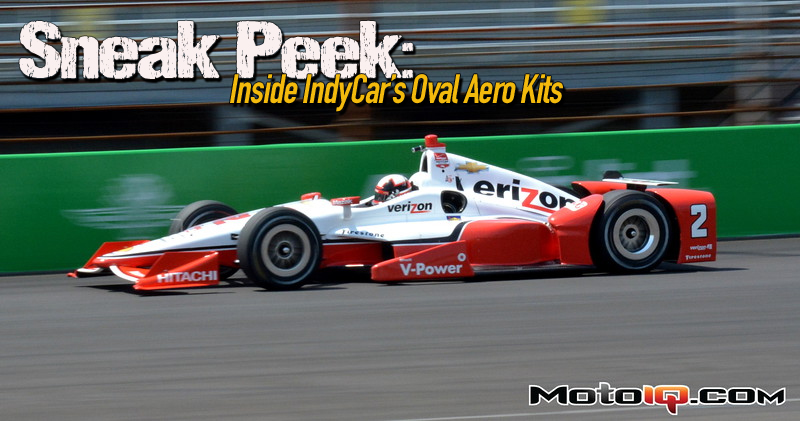
Sneak Peek: Inside IndyCar's Oval Aero Kits
IndyCar is a fickle sport. On the one hand, no other racing series in the world competes on as many types of racing circuit as IndyCar does. Few series can boast the close level of racing IndyCar does (13 different winners in 18 the races of 2014). IndyCar has a deep level of talent with drivers who have come from all walks of life, including a number of ex-Formula 1 drivers. Team Penske’s drivers alone share four Indy 500 wins, two IndyCar championships, 67 IndyCar wins, 7 Formula 1 wins, 3 NASCAR victories, two 24 Hours of Daytona victories, 2 V8 Supercar wins, and an ALMS championship. That is a lot of wins spread across four drivers and in a wide variety of cars. How many other motorsports teams can claim that kind of diversity?
Unfortunately, despite the close racing and huge depth of talent, IndyCar has been lacking in the technology department for many years. In 2011, every single IndyCar was a Honda V8 powered Dallara car that was leftover from the oval-only Indy Racing League (IRL) days. In order to attract new teams and prevent costs from spiraling out of control, Dallara was tasked with building the DW-12 (so named for the late Dan Wheldon who performed all of the test driving for the car before he was killed in the closing IndyCar race at Las Vegas in 2011). The DW12, which we have showed you before, is a spec car as its predecessor the IR-07 was. Unlike the IR-07, teams have a choice of Honda or Chevrolet turbocharged V6 engines. The spec car was introduced with the promise that in the future, body kits would be available from select manufacturers to try and create cost effective diversity in the field. With much of the rest of the chassis locked into Dallara spec, this would prevent huge teams like Penske from running away from smaller teams.
In 2015, those new kits finally came to light. In February Chevy and Honda both unveiled their road course aero kits, which have been used at the first four IndyCar races in the 2015 calendar. However Indy runs on huge superspeedways and if you know anything about IndyCar, you know the granddaddy of all IndyCar races is the Indianapolis 500. On Sunday May 3rd, the first public test of the new oval aero kits happened at the Brickyard and MotoIQ was there, spying on teams and getting the scoop on these new aero kits.
 We start our look at Indy’s latest oval cars with the prototypes of the DW12 from 2011 (taken at the 2011 Indy 500). These were taken before the DW12 had actually turned a wheel yet. This was the prototype for the oval car. The road course car is behind it. Test driver Dan Wheldon only competed in two races in 2011. The first was the Indy 500, which he won. That win scored Bryan Herta Autosport the testing contract for the DW12 with Wheldon as the test driver. The second race was the season closer in Las Vegas where Wheldon sustained fatal head injuries after a vicious multi car accident.
We start our look at Indy’s latest oval cars with the prototypes of the DW12 from 2011 (taken at the 2011 Indy 500). These were taken before the DW12 had actually turned a wheel yet. This was the prototype for the oval car. The road course car is behind it. Test driver Dan Wheldon only competed in two races in 2011. The first was the Indy 500, which he won. That win scored Bryan Herta Autosport the testing contract for the DW12 with Wheldon as the test driver. The second race was the season closer in Las Vegas where Wheldon sustained fatal head injuries after a vicious multi car accident. The rear wing is quite large for a car that can do over 220 MPH. The undertray and floor are also pretty simple for a top tier racecar. But then again, this was just a concept. The rear wheel guards have been controversial ever since Dallara’s concept car debuted in late 2010, with fans claiming they make the car look fat and ungainly. They help prevent the cars from climbing over each other in a crash. Dan Wheldon’s fatal accident may have had a drastically different outcome had these wheel guards been in place. Remember, these are racecars, form follows function! They also help condition the air coming off the rear tires, so there is some aero benefit as well as the safety aspects.
The rear wing is quite large for a car that can do over 220 MPH. The undertray and floor are also pretty simple for a top tier racecar. But then again, this was just a concept. The rear wheel guards have been controversial ever since Dallara’s concept car debuted in late 2010, with fans claiming they make the car look fat and ungainly. They help prevent the cars from climbing over each other in a crash. Dan Wheldon’s fatal accident may have had a drastically different outcome had these wheel guards been in place. Remember, these are racecars, form follows function! They also help condition the air coming off the rear tires, so there is some aero benefit as well as the safety aspects. The final cars differed quite a bit from the prototypes. That big rear wing was replaced with this much smaller wing. The front wing was also downsized a bit. These new-era cars are very dependent on under-body aero to maintain the downforce needed to go 225 at Indy. These cars can go through the corners flat-out at the speedway. These new cars are so fast that Ed Carpenter’s 2014 pole lap would have beat Al Unser Jr. in 1994. 1994 was the year of the Mercedes Benz monster 1,000 hp pushrod engine, which made 400 hp more than the current crop of Indy V6 engines do today. All of that speed is from the advancements in aero, tires, and suspension over the last 20 years. Despite their speed, the DW12 bodywork allowed for easy drafting and produced great racing in the last three Indy 500s.
The final cars differed quite a bit from the prototypes. That big rear wing was replaced with this much smaller wing. The front wing was also downsized a bit. These new-era cars are very dependent on under-body aero to maintain the downforce needed to go 225 at Indy. These cars can go through the corners flat-out at the speedway. These new cars are so fast that Ed Carpenter’s 2014 pole lap would have beat Al Unser Jr. in 1994. 1994 was the year of the Mercedes Benz monster 1,000 hp pushrod engine, which made 400 hp more than the current crop of Indy V6 engines do today. All of that speed is from the advancements in aero, tires, and suspension over the last 20 years. Despite their speed, the DW12 bodywork allowed for easy drafting and produced great racing in the last three Indy 500s.For 2015 Honda and Chevrolet were allowed to develop their own front and rear wings, sidepods, engine cover, and rear wheel guards. The tub, suspension, transmission, floor, and air intake are all Dallara parts. IndyCar unveiled CAD renderings of each car in the days leading up to the opening test session. So let’s start our look at the 2015 Indy 500 cars here.
 First we have the Chevrolet kit, developed by Pratt & Miller (the team that campaigns Chevrolet’s factory Corvette team at Le Mans and in the Tudor sports Car Series). Right away you will notice the rear wing is even smaller than on the standard Dallara! It sits much lower and there are no end fences, not even coming off the wheel guards. The side pods also have an odd contour leading between the suspension. This likely channels air over the floor, aiding the diffuser. The front wing seems a bit large for a car with such little rear wing, lending credence to this being an even more undertray dependent car than the standard DW12.
First we have the Chevrolet kit, developed by Pratt & Miller (the team that campaigns Chevrolet’s factory Corvette team at Le Mans and in the Tudor sports Car Series). Right away you will notice the rear wing is even smaller than on the standard Dallara! It sits much lower and there are no end fences, not even coming off the wheel guards. The side pods also have an odd contour leading between the suspension. This likely channels air over the floor, aiding the diffuser. The front wing seems a bit large for a car with such little rear wing, lending credence to this being an even more undertray dependent car than the standard DW12.


